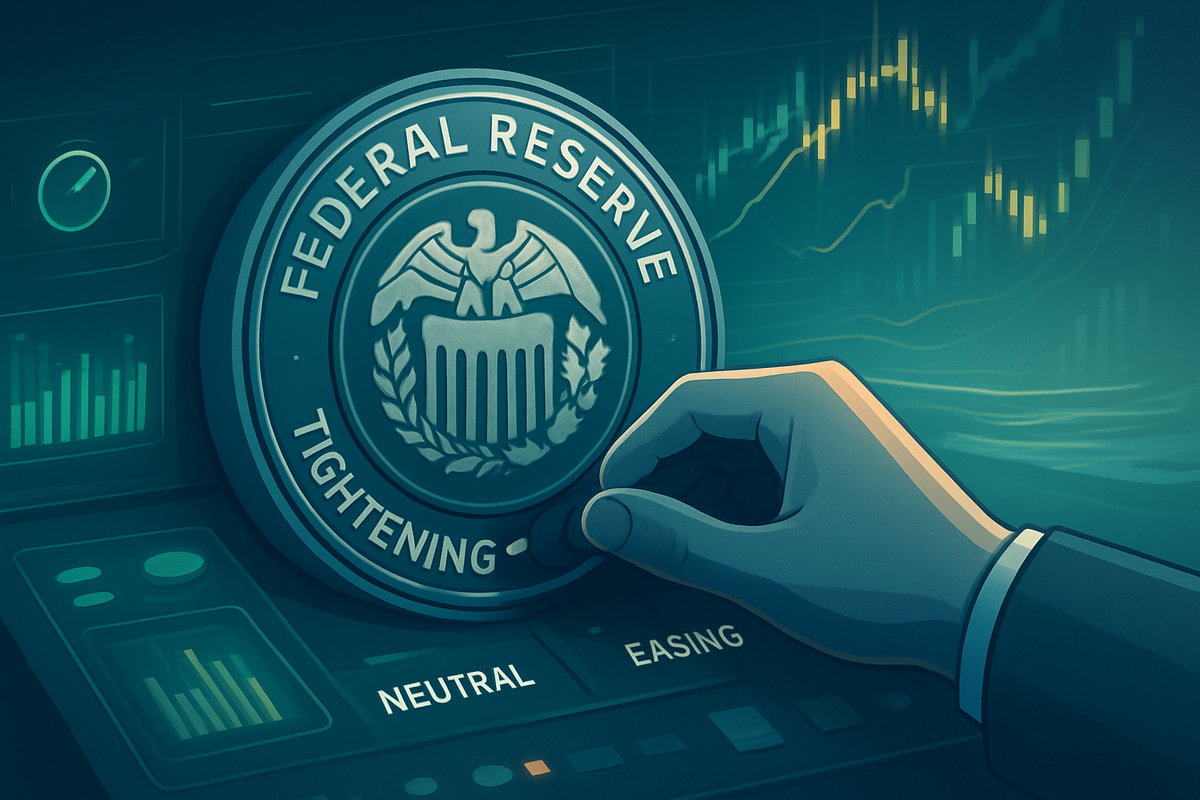FOMC Signals End to Quantitative Tightening in December, Reshaping Treasury Funding Landscape

Washington D.C. - The Federal Open Market Committee (FOMC) is poised to conclude its ambitious balance sheet reduction program, commonly known as quantitative tightening (QT), on December 1, 2025. This pivotal decision marks a significant shift in monetary policy, transitioning from a period of aggressive liquidity withdrawal to a more neutral stance. The halt to the balance sheet run-off carries profound implications for U.S. Treasury funding, potentially easing the government's borrowing costs, while simultaneously reshaping broader market liquidity dynamics and the operational framework for monetary policy.
The impending cessation of QT signals the Federal Reserve's assessment that its balance sheet has reached a size consistent with "ample reserves" in the banking system, a key metric for effective monetary policy implementation. This move is expected to alleviate some of the pressure on the U.S. Treasury, which has faced the dual challenge of increased borrowing needs and reduced demand from its largest buyer – the Fed – during the QT period. For financial markets, the end of the balance sheet shrinkage could usher in a new phase of stability, potentially reducing volatility and providing a more predictable environment for interest rates and asset valuations.
The Federal Reserve's Pivotal Policy Shift
The journey to this December 2025 halt began in June 2022, when the FOMC initiated its quantitative tightening program. The objective was clear: to reverse the massive expansion of the Fed's balance sheet, which had swelled to nearly $9 trillion during the era of quantitative easing (QE) aimed at stimulating the economy post-pandemic. Over the subsequent 30 months, the Fed allowed its holdings of U.S. Treasury securities and mortgage-backed securities (MBS) to mature without reinvesting the principal payments, effectively removing over $2 trillion in liquidity from the financial system. This deliberate and sustained reduction brought the balance sheet down to approximately $6.6 trillion.
The decision to conclude QT on December 1, 2025, reflects a multi-faceted assessment by the FOMC. Firstly, it indicates a growing confidence that inflation is sufficiently under control, no longer necessitating such an aggressive tightening of financial conditions. Secondly, concerns regarding potential strains in money markets and the need to maintain "ample reserves" within the banking system have likely played a significant role. The Fed aims to avoid a repeat of the September 2019 repo market turmoil, which occurred during a previous QT cycle and necessitated emergency liquidity injections. In the months leading up to the December halt, the Fed has already demonstrated a proactive approach to managing liquidity, including a federal funds rate cut in October 2025 to 3.75-4% and a substantial $29.4 billion injection into the banking system via overnight repurchase agreements on October 31, 2025. These actions underscore the Fed's commitment to ensuring smooth market functioning as it navigates this policy transition.
Upon concluding the run-off, the Fed will transition to a maintenance phase, reinvesting all principal payments from maturing Treasury securities and agency MBS. Crucially, proceeds from maturing MBS will be reinvested into short-term Treasury bills. This strategy aims to gradually shift the Fed's portfolio towards one primarily composed of Treasury securities, moving away from its significant holdings of MBS accumulated during past QE programs. This strategic shift in reinvestment will further influence the composition of demand in the Treasury market.
Market Winners and Losers from Easing Liquidity
The conclusion of the FOMC's balance sheet run-off is poised to create distinct winners and losers across the financial landscape, primarily by altering the dynamics of Treasury funding and broader market liquidity.
Potential Winners:
- U.S. Treasury: The most direct beneficiary will likely be the U.S. Treasury itself. With the Federal Reserve ceasing to be a net seller (or rather, a non-reinvestor) of Treasury securities, a significant source of supply pressure will be removed from the market. This could lead to lower yields on newly issued Treasury bonds, thereby reducing the government's borrowing costs. The Treasury will still need to issue substantial debt to finance deficits, but the absence of the Fed's balance sheet shrinkage should make the funding process smoother and potentially cheaper.
- Commercial Banks (NYSE: JPM, BAC, WFC): The end of QT implies that the decline in bank reserves, which has been a direct consequence of the balance sheet run-off, will halt. While the Fed will not be actively adding reserves, the cessation of their drain will stabilize the level of reserves in the banking system. This provides greater certainty for banks regarding their liquidity positions and regulatory compliance. Furthermore, if the halt to QT is perceived as a dovish signal, it could lead to a steeper yield curve (long-term rates rising relative to short-term rates), which traditionally benefits banks by improving their net interest margins.
- Bond Market Dealers and Investors: Increased stability in the Treasury market and potentially lower volatility in yields could benefit bond market dealers and investors who thrive on predictable market conditions. The reinvestment of MBS proceeds into Treasury bills will also ensure continued demand for short-term government debt.
- Companies Sensitive to Interest Rates (e.g., Real Estate, Utilities): If the cessation of QT, combined with ongoing rate cuts, leads to a sustained period of lower long-term interest rates, companies in sectors that are highly sensitive to borrowing costs, such as real estate investment trusts (REITs) (e.g., NYSE: O, SPG) and utilities (e.g., NYSE: D, SO), could see their financing costs decrease, potentially boosting profitability and investment.
Potential Losers/Challengers:
- Money Market Funds: During QT, as bank reserves declined, money market funds often saw inflows as liquidity sought alternative, safe havens. With the stabilization of bank reserves and potentially lower short-term rates, the relative attractiveness of money market funds might diminish, leading to a reallocation of funds elsewhere.
- Fixed Income Investors Seeking Higher Yields: For investors whose primary objective is to maximize yield in safe assets, the potential for lower Treasury yields following the end of QT might be a challenge. They may need to consider moving further out on the credit or duration curve to achieve their desired returns, introducing additional risk.
- The Federal Reserve's Remittances to the Treasury: While not a "loser" in the traditional sense, the Fed's remittances to the Treasury have been significantly impacted by QT and higher interest rates paid on reserves. The research indicates that the Fed has anticipated operating losses through 2028, keeping remittances low until 2029. While the end of QT might stabilize the balance sheet, the existing interest rate environment could continue to suppress these remittances for some time, impacting federal revenue.
The overall impact hinges on how market participants interpret the Fed's actions in the context of broader economic conditions, particularly inflation and economic growth.
Broader Significance and Historical Context
The FOMC's decision to halt its balance sheet run-off in December 2025 is a monumental step that resonates far beyond the immediate confines of Treasury funding. It signifies a crucial inflection point in the Federal Reserve's post-pandemic monetary policy trajectory, marking a definitive end to an era of aggressive liquidity withdrawal and heralding a return to a more normalized, albeit still evolving, operational framework.
This event fits squarely into broader industry trends of central banks globally grappling with the unwinding of extraordinary measures taken during periods of crisis. Many central banks have engaged in similar quantitative easing and tightening cycles, and the Fed's experience will provide valuable lessons. The move indicates a potential shift from fighting inflation as the primary concern to balancing price stability with supporting economic growth and employment. The simultaneous rate cuts in late 2025 further underscore this pivot, suggesting that the FOMC is becoming more responsive to signs of economic softening, such as a weakening labor market.
The potential ripple effects are extensive. For competitors and partners in the global financial system, the Fed's policy shift can influence capital flows and currency valuations. A more accommodative Fed might lead to a weaker U.S. dollar, impacting trade balances and the competitiveness of U.S. exports. Emerging markets, in particular, often benefit from a less aggressive Fed, as it can reduce pressure on their currencies and ease their dollar-denominated debt burdens.
From a regulatory and policy perspective, the conclusion of QT will allow regulators and the Fed to more precisely assess the "ample reserves" framework. The Fed's stated goal is to maintain a level of reserves "somewhat above the level consistent with ample reserves," but defining and maintaining this optimal level is an ongoing challenge. The experience of the 2019 repo market stress, which occurred during a prior QT episode, serves as a stark historical precedent, highlighting the risks of misjudging liquidity needs. The current Fed's proactive liquidity injections and rate cuts suggest a learned lesson from this history, aiming to prevent similar disruptions. This current cycle of QT, starting in June 2022, has been more aggressive and sustained than its 2017-2019 predecessor, reducing the balance sheet by a larger magnitude. The strategic shift to reinvest MBS into T-bills also reflects a long-term policy goal of simplifying the Fed's balance sheet, focusing predominantly on Treasury securities.
What Comes Next: A Glimpse into the Future
The cessation of quantitative tightening in December 2025 opens up a spectrum of possibilities for the U.S. economy and financial markets, with both short-term adjustments and long-term strategic implications.
In the short-term, we can expect a period of market recalibration. The immediate impact will likely be a stabilization of bank reserves, removing a key source of downward pressure on liquidity. This could contribute to less volatile overnight funding markets. The U.S. Treasury will be closely watched as it navigates its funding needs without the Fed actively shrinking its balance sheet. While borrowing costs might ease, the sheer volume of government debt issuance will remain a significant factor. Short-term Treasury yields, particularly T-bills, could see increased demand as the Fed reinvests MBS proceeds into this segment. Investors may also interpret the halt to QT, coupled with recent rate cuts, as a signal of further monetary easing to come, potentially leading to a "risk-on" sentiment in equity markets.
Long-term possibilities include a more stable and predictable monetary policy environment. With the balance sheet size effectively "normalized," the Fed's primary tool for managing inflation and economic growth will revert more squarely to the federal funds rate. This could lead to a clearer understanding of the Fed's reaction function and reduce market uncertainty. The shift in the Fed's portfolio composition towards predominantly Treasury securities will simplify its operations and provide greater transparency. However, the exact "ample reserves" level will remain a subject of ongoing monitoring and potential fine-tuning, as the banking system's structural liquidity needs can evolve.
Strategic pivots or adaptations will be required across various market participants. Banks will need to adjust their liquidity management strategies in an environment of stable, rather than declining, reserves. Bond investors will need to factor in the Fed's renewed demand for short-term Treasuries and the overall impact on the yield curve. Corporations might find a more favorable environment for financing their operations and investments if long-term rates remain subdued or decline further. Market opportunities may emerge in sectors that benefit from lower interest rates and stable liquidity, while challenges could arise for those who thrived on the volatility or specific market dislocations created by QT.
Potential scenarios range from a "soft landing" where the economy avoids a recession and inflation remains contained, to a more challenging environment if underlying economic weaknesses persist despite the Fed's easing. The effectiveness of the Fed's policy pivot in stimulating growth without reigniting inflation will be the ultimate determinant of market outcomes.
Comprehensive Wrap-up and Forward Look
The FOMC's decision to conclude its balance sheet run-off in December 2025 represents a landmark moment in post-pandemic monetary policy. The key takeaway is a definitive shift from aggressive quantitative tightening to a more neutral, and potentially accommodative, stance. This pivot is primarily driven by the Fed's assessment of achieving its "ample reserves" target and a growing emphasis on supporting economic stability amidst signs of softening growth and contained inflation.
Moving forward, the market can anticipate a more stable liquidity environment. The immediate pressure on U.S. Treasury funding should ease, potentially leading to more favorable borrowing costs for the government. For financial institutions, the stabilization of bank reserves offers greater certainty, while the broader economy may benefit from potentially lower long-term interest rates. However, the significant volume of Treasury issuance to finance ongoing deficits will remain a critical factor to watch.
The lasting impact of this event will be multifaceted. It reinforces the Fed's commitment to avoiding past liquidity crunches and refining its operational framework. It also sets the stage for a period where interest rate adjustments, rather than balance sheet changes, will be the primary lever of monetary policy. Investors should closely monitor the Fed's communication regarding its "ample reserves" framework, any further shifts in its reinvestment strategy, and, critically, the trajectory of inflation and employment data. The effectiveness of this policy pivot in fostering sustainable economic growth without reigniting price pressures will define the market landscape in the coming months and years.
This content is intended for informational purposes only and is not financial advice



